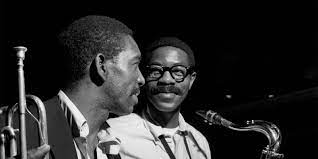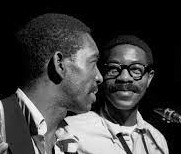If the expression “auspicious beginning” hadn’t already been coined by 1963, Joe Henderson’s Page One would have inspired it. The tenor saxophonist made his masterful debut as a leader on June 3 of that year, eight weeks after appearing on record for the first time on Kenny Dorham’s Una Mas. Joe had joined KD’s quintet shortly after his arrival in New York in the late summer of 1962, and the trumpeter appeared with Joe on Page One. Dorham also premiered his evergreen “Blue Bossa” on the date, and wrote the liner notes too. He hailed Joe as “indubitably one of the most musical young saxophonists to show since Charlie Parker.”

Speaking of Bird, Henderson told Mel Martin in a 1991 interview for Saxophone Journal that when he studied music at Wayne State University in the late ’50’s, he “learned every Charlie Parker tune that was ever written,” but that his early background in Lima, Ohio, gave him plenty of exposure to both R&B and C&W. “I know as much about Johnny Cash as I do about Charlie Parker, because I grew up in that area. This was all we heard on the radio…When I got a little older, I would go out to these dances…When James Brown, B.B. King, and these cats would come to my hometown, I’d be there checking out the saxophone players. ”
Henderson’s early exposure to jazz came primarily through a “jazz buff” brother who turned him on to a Jazz at the Philharmonic album where he heard Lester Young (“the first influence that I could single out”), Illinois Jacquet, and Flip Phillips. Through this and other records, including Lester’s “D.B. Blues,” he “knew what the saxophone was supposed to sound like” before he began playing it. Joe’s interests were impressively wide-ranging, including the classical modernists Bartok, Hindemith, and Stravinsky. Stan Getz was a formative influence, and the harmonic outer limits that intrigued him were modeled most compellingly by tenor saxophonist Warne Marsh on his 1949 recordings with the Lennie Tristano Sextet and the Lee Konitz Quintet.

(Lennie Tristano, Lee Konitz, Warne Marsh, 2nd, 3rd, and 4th from left)
In Unsung Cat: The Life and Music of Warne Marsh, Henderson told biographer Safford Chamberlain, “I could have had a hundred other records and they wouldn’t have meant as much to me as that one album,” which included “Marshmallow,” “Fishin’ Around,” “Tautology,” and “Sound-Lee.” Henderson added, “A vital part of whatever it is I’m about today, I’m sure came from that zone, from hearing players like Marsh and Konitz who had some technical mastery over the instrument as well as great feeling.”
Henderson echoed an article of faith in the Tristano-Konitz-Marsh manifesto when he told Martin, “Having a sense of composition has served me well, and also having a rich sense of rhythm, and a desire not to repeat stuff. I consider it one of the worst sins a musician could possibly commit, to play an idea more than one time. You’ve got to keep changing things around, keep inventing, and especially when you’re making records. I came into it thinking of change as a constant thing.”

I recommend reading the entire conversation between Henderson and Martin, which you’ll find here. And tune in for Page One in tonight’s Jazz a la Mode. Over the course of the year, the golden anniversary series will also include Dorham’s Una Mas and Joe’s Page One follow-up, Our Thing.
Henderson enjoyed a late-career flurry of acclaim for a series of recordings he made in the ‘90’s beginning with Lush Life, an album devoted to compositions by Billy Strayhorn. The record was a critical and commercial success, selling over 90,000 copies, and it proved to be the first of three Grammy winners he enjoyed in the final decade of his life. On Lush Life, he played “Take the A Train” as a duo with drummer Gregory Hutchinson. It begins in similar fashion here with Al Foster before George Mraz and Bheki Mseleku join in. Enjoy!
